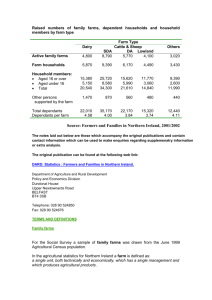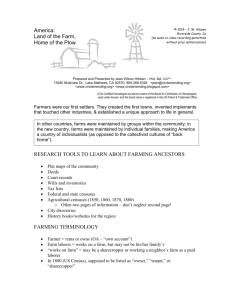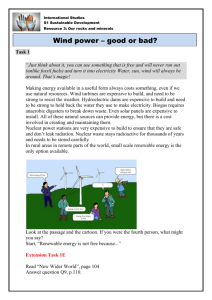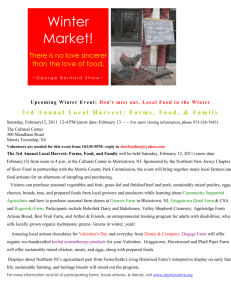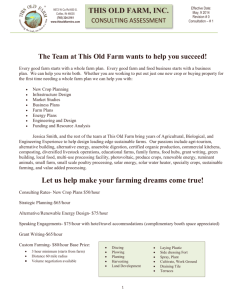Percentage distribution of farms by number and gender of farmers
advertisement
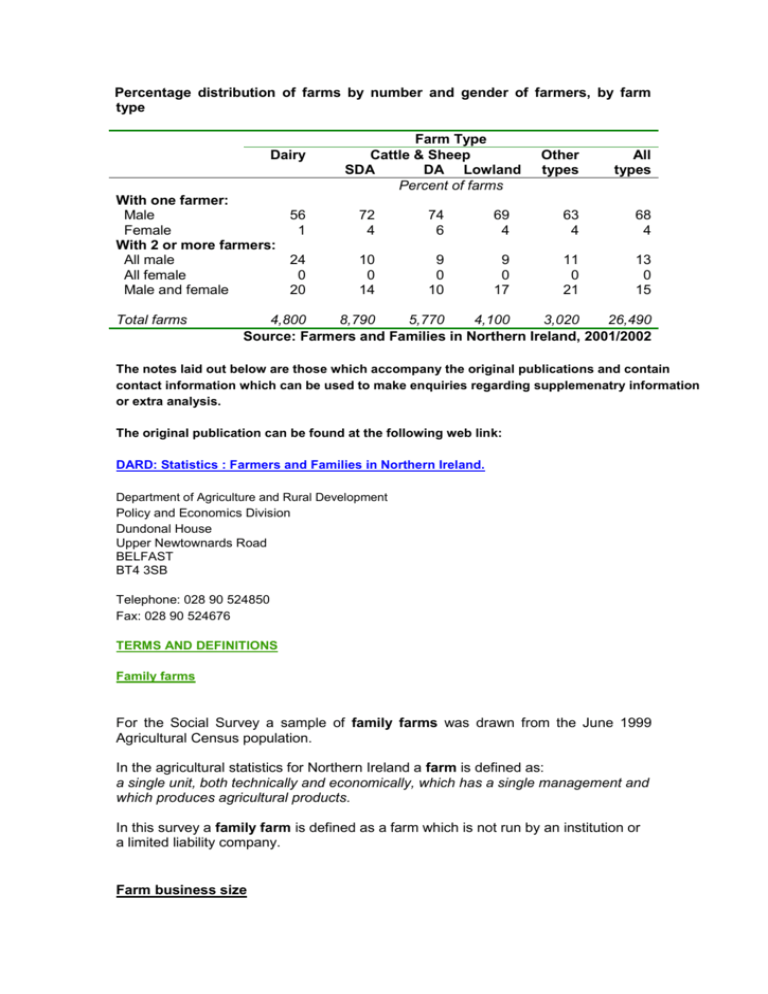
Percentage distribution of farms by number and gender of farmers, by farm type Dairy With one farmer: Male 56 Female 1 With 2 or more farmers: All male 24 All female 0 Male and female 20 Total farms Farm Type Cattle & Sheep SDA DA Lowland Percent of farms Other types All types 72 4 74 6 69 4 63 4 68 4 10 0 14 9 0 10 9 0 17 11 0 21 13 0 15 4,800 8,790 5,770 4,100 3,020 26,490 Source: Farmers and Families in Northern Ireland, 2001/2002 The notes laid out below are those which accompany the original publications and contain contact information which can be used to make enquiries regarding supplemenatry information or extra analysis. The original publication can be found at the following web link: DARD: Statistics : Farmers and Families in Northern Ireland. Department of Agriculture and Rural Development Policy and Economics Division Dundonal House Upper Newtownards Road BELFAST BT4 3SB Telephone: 028 90 524850 Fax: 028 90 524676 TERMS AND DEFINITIONS Family farms For the Social Survey a sample of family farms was drawn from the June 1999 Agricultural Census population. In the agricultural statistics for Northern Ireland a farm is defined as: a single unit, both technically and economically, which has a single management and which produces agricultural products. In this survey a family farm is defined as a farm which is not run by an institution or a limited liability company. Farm business size Farm business size is determined by calculating each farm’s total Standard Gross Margin (SGM). The gross margin of an enterprise is its total output less the variable costs which are directly attributable to it. SGM coefficients representing standards or norms have been calculated for all major enterprises. The total SGM for each farm is calculated by multiplying its crop areas and livestock numbers by the appropriate SGM coefficients and then summing the result for all enterprises on the farm. To be able to determine year-to-year changes in business size, the enterprise SGM coefficients are held constant for a number of years. The current series (introduced in 1993) is based on the average prices during the period 1987-89. For a list of these values, see ‘The Agricultural Census in Northern Ireland: Results for 2001’. Because the system of classifying business size was developed for use within the EU statistical network, SGMs are measured in euros. In agricultural statistics for Northern Ireland, business size is generally described in terms of four SGM size bands1. These are: Term 1987-1989 SGM (euro*) <9,600 9,600-<48,000 48,000-<120,000 120,000 or more Very small Small Medium Large * 1 euro = 1 ECU (was = £0.68 in 1987-1989). European Size Units (ESU)* less than 8 8-<40 40-<100 100 or more 1 ESU=€1,200 of SGM The distribution of farms in Northern Ireland is heavily skewed towards the lower end of the size range. Over half the farms are classed as Very Small, with relatively few Medium or Large businesses though farms of these latter sizes contribute over half the total SGM2. Farm business type The EU system of classifying farms according to farm type (on which the UK system is based) is set out in Commission Decision 85/377/EEC. Although 75 different types are recognised by the EU, only 58 of these exist in Northern Ireland. For sampling and raising purposes these were grouped into 19 key types, then further regrouped into 5 main types for the purpose of this report. These are: Type Definition Dairy farms with more than 2/3 of their total SGM in dairying (including associated young stock). Cattle & sheep farms wholly or mainly in the Severely Disadvantaged Areas which do not qualify as dairy farms but have more than 2/3 of their total SGM in 1 A reassessment of the UK typology system currently being undertaken will be informed by the results of this survey. 2 See Statistical Review of Northern Ireland Agriculture 2001, Chapter 4. (SDA) cattle and sheep. Cattle & sheep (DA) farms wholly or mainly in the Disadvantaged Areas which do not qualify as dairy farms but have more than 2/3 of their total SGM in cattle and sheep. Cattle & sheep (lowland) farms entirely or mainly outside the Less Favoured Areas, which do not qualify as dairy farms but have more than 2/3 their total SGM in cattle and sheep. All other types All other farms, including specialists in cereals, general cropping, horticulture, mushrooms, pigs, poultry, or other livestock, and mixed farms. Less favoured areas (Figure A) The term Less Favoured Areas (LFA) is used to describe those parts of the country which, because of the relatively poor agricultural conditions which prevail there, have been so designated under EU legislation. This recognition allows those who farm there to apply for special support, such as the Less Favoured Areas Compensatory Allowances Scheme. The LFA is composed of a Severely Disadvantaged Area (SDA), which is the original LFA as designated in 1975 (487,000 hectares), and the Disadvantaged Area (DA) which was designated following reviews in 1984 (335,000 hectares) and 1990 (3,700 hectares). (The areas designated include some non-agricultural land). Fig. A Less Favoured Areas NORTHERN IRELAND Less Favoured Areas Lowland Disavantaged Area Severely Disadvantaged Area Reproduced from the Ordnance Survey map of Northern Ireland. Crown Copyright 2002. Farm diversification Farm diversification comprises any productive activity which uses the resources of the farm, other than for mainstream farming. Interviewees were shown the following list of farm diversification activities. Contract field work Contract milking Contract sheep shearing Contract hedge cutting Livestock haulage Other contract farm work Bed & breakfast Self-catering accommodation Open farm Caravan/ camping site Sports facilities (not horses) Other tourism facilities (not equestrian) Horse breeding Horse livery Other equestrian facilities or services Pick your own fruit or vegetables Farm shop or stall Market stall Other direct sales of farm produce Fruit or vegetable processing or packing Other farm produce processing or packing Mushrooms Organic produce New horticultural/ agricultural crops (not cereals/potatoes/fodder) Gardening services Novel livestock Bees Fish farming Machinery repairs Light engineering Boarding kennels/ cattery Livestock grooming Business administration services Letting buildings for non-agricultural use Craft work for commercial gain Other services for commercial gain

